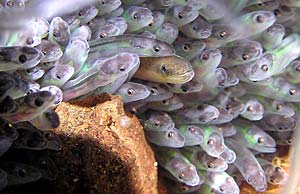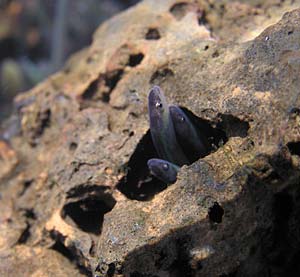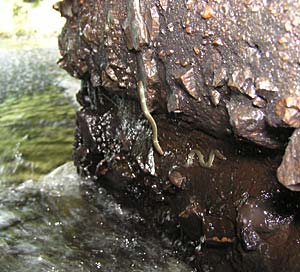Save the Eel
Air Date: Week of May 20, 2005

Young eels attempting to climb through the dam spillgate at Weweantic River, MA. (Photo: Tim Watts ©2004/5)
Tim and Doug Watts have been fascinated with eels since they were kids growing up in Easton, Massachusetts. Now, as adults, the brothers are on a mission: to get the government to protect the American Eel as an endangered species. Nancy Cohen of member station WNPR spent the day with the Watts to find out why they’re concerned about this slimy creature.
Transcript
CURWOOD: It’s Living on Earth. I’m Steve Curwood and coming up, how old people will save the world. But first: when it comes to protecting animals there are some that are an easy sell to the public--the ones with melodic songs, furry skin, bright colors or majestic size. But that leaves out most fish. The brothers Doug and Tim Watts want to protect a fish with a slimy reputation: the American Eel. They want it placed on the endangered species list. From member station WNPR in Hartford, Nancy Cohen explains why.
COHEN: Forty-year-old Doug Watts says when he and his big brother Tim were growing up in Easton, Massachusetts the woods and streams were their playground.
[AMBIENCE OUTSIDE TIM’S HOUSE]
D. WATTS: We could come home covered with mud. We could come home with snakes with turtles, with frogs, with bugs, you name it.
|
COHEN: And eels. They used eels as bait to catch striped bass on Cape Cod. And Tim recalls the time he and Doug saw an eel unlike any other they’d seen before. They were fishing in a pond with their father and they noticed some fishing tackle floating by. T.WATTS: We said ‘hey dad look at that bobber lets go grab it.’ So we pulled up our lines and went paddling over there and He hauled it up and there was this great big eel that, you know, was probably three feet long D. WATTS: It was black too! It was almost coal black. T. WATTS: It was probably as big around as your arm. COHEN: They cut the line and let the eel go, but the impression it made stayed with them. Today, Doug’s a writer with the Atlantic Salmon Journal in Maine and fights to protect migrating fish. Tim, a former Marine, is a janitor by night and keeps an eye on the eels by day. One place he checks on them is not far from his home: the Weweantic River in Wareham, Massachusetts. [SOUND OF WEWEANTIC DAM]  Glass eels & elvers stuck beneath the Horseshoe Pond Dam, Weweantic River Wareham, MA. (Photo: Tim Watts ©2004/5) |
T. WATTS: Couple days ago this place was loaded with ‘em up here all these little pockets in the rocks would be full of these little clumps of eels and I see very few up here now. I have a funny feeling somebody’s up here poaching them. COHEN: Tim says fishing for the American Eel is one reason its numbers are declining. Eels are considered a culinary delicacy. And demand from Asia and Europe has pushed up the price. Young eels are going for 275 dollars a pound this spring in Maine. And they face other threats including contaminants in rivers and loss of wetland habitat. Six months ago, the Watts brothers filed a petition with the U-S Fish and Wildlife Service asking that the American eel be listed as endangered. Experts are also concerned. A year ago, the Atlantic States Marine Fisheries Commission issued a statement saying the government should consider the American Eel a candidate for listing under the Endangered Species Act. A defining moment for the Watts brothers came nine years ago when they found a mass of migrating eels stuck below this old mill dam on the Weweantic River. The brothers spent several nights netting them and moving them over the dam. T. WATTS: If they have to sit below this dam three weeks two weeks a month you get a huge amounts of mortality through predators that you wouldn’t otherwise get if they had free passage upstream. COHEN: Every spring, Tim sees the same thing: one-year-old American Eels that can’t get past this dam. They’re only a little bigger than a toothpick and spend a lot of time hiding from predators like fish, crabs and birds. [SOUND OF WEWANTIC WATER] T. WATTS: And you turn over a rock [grunts] and from under the rock they all go squiggling away.
|







